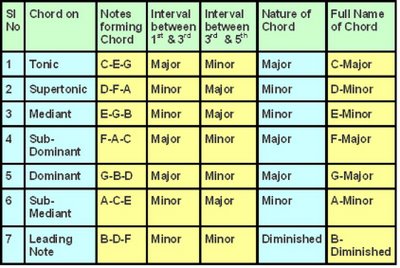Let us proceed with the study of different chords, (the triads as we normally know them for a three notes chords), that are coming on any Major Scale.
As decided earlier we will take C-Major as our example scale for our study.
The triads are formed by the adding of 1st , 3rd, and 5th notes together on any given note.
The notes of C-Major are C-D-E-F-G-A-B-C.
So the 7 triads that can be formed on the notes of C-Major are as follows :
Triad on C – the Tonic ------------------ C-E-G
Triad on D – the Super Tonic ---------- D-F-A
Triad on E – the Mediant --------------- E-G-B
Triad on F – the Sub-Dominant ------- F-A-C
Triad on G – the Dominant ------------- G-B-D
Triad on A – the Sub-Mediant --------- A-C-E
Triad on B – the Leading note --------- B-D-F
Now in order to name these chords, we should know the nature of intervals in between 1st & 3rd as well as 3rd & 5th .
Let us tabulate these intervals and hence the name of Chords derived as follows:

From the above table, we can summarise, for our easy remembering that, in a Major scale,
· the triads (chords of 3 notes) on the Tonic , Sub-Dominant and Dominant are Major Chords;
· the triads on Supertonic, Mediant, Sub-Mediant etc are Minor Chords;
· the triad formed on leading note is a Diminished Chord.
So 3 Major Chords, 3 Minor Chords, 1 Diminished chord are there in any Major Scale.
The above is applicable to any Major scale, be it on Sharps or on Flats…!
For example,
the triad on Dominant of G Major scale will be D - F# - A which is a Major chord…
(….must be major chord as per our generalisation above…!)
Another example, the triad on leading note of E-Major will be D# - F# - A , which is a Diminished Chord
(…yes….must be diminished chord… )
So, remembering the notes sequence of a Major Scale, we can easily write the chords formation and specify the characteristics of such triads based on the location of base note from Tonic.
As decided earlier we will take C-Major as our example scale for our study.
The triads are formed by the adding of 1st , 3rd, and 5th notes together on any given note.
The notes of C-Major are C-D-E-F-G-A-B-C.
So the 7 triads that can be formed on the notes of C-Major are as follows :
Triad on C – the Tonic ------------------ C-E-G
Triad on D – the Super Tonic ---------- D-F-A
Triad on E – the Mediant --------------- E-G-B
Triad on F – the Sub-Dominant ------- F-A-C
Triad on G – the Dominant ------------- G-B-D
Triad on A – the Sub-Mediant --------- A-C-E
Triad on B – the Leading note --------- B-D-F
Now in order to name these chords, we should know the nature of intervals in between 1st & 3rd as well as 3rd & 5th .
Let us tabulate these intervals and hence the name of Chords derived as follows:

From the above table, we can summarise, for our easy remembering that, in a Major scale,
· the triads (chords of 3 notes) on the Tonic , Sub-Dominant and Dominant are Major Chords;
· the triads on Supertonic, Mediant, Sub-Mediant etc are Minor Chords;
· the triad formed on leading note is a Diminished Chord.
So 3 Major Chords, 3 Minor Chords, 1 Diminished chord are there in any Major Scale.
The above is applicable to any Major scale, be it on Sharps or on Flats…!
For example,
the triad on Dominant of G Major scale will be D - F# - A which is a Major chord…
(….must be major chord as per our generalisation above…!)
Another example, the triad on leading note of E-Major will be D# - F# - A , which is a Diminished Chord
(…yes….must be diminished chord… )
So, remembering the notes sequence of a Major Scale, we can easily write the chords formation and specify the characteristics of such triads based on the location of base note from Tonic.
No comments:
Post a Comment